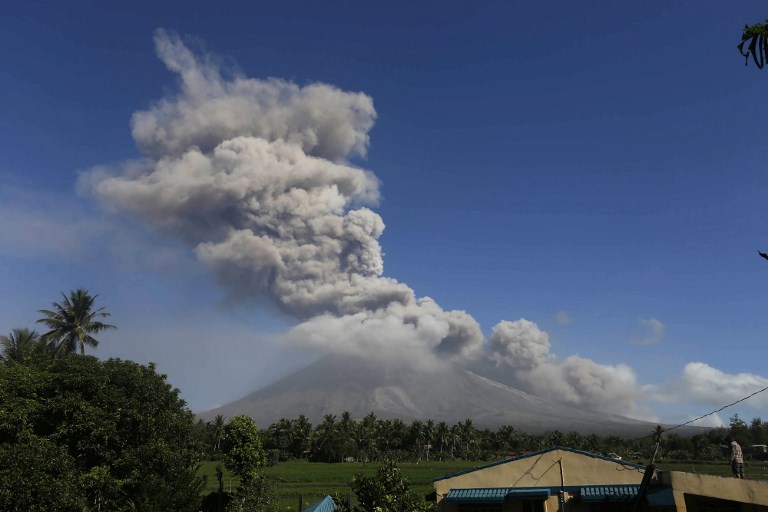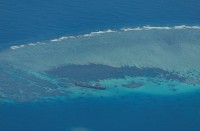
A giant mushroom-shaped cloud shot up from the Philippines’ most active volcano on January 22, witnesses and officials said, darkening the skies and raining ash on surrounding communities where tens of thousands have fled an impending eruption. / AFP PHOTO / LINUS ESCANDOR II
(Eagle News) – More ash explosions were seen this morning, January 23, in Mayon Volcano as volcanologists warned of continuous explosions after it raised the volcano’s alert level to number 4, meaning hazardous eruption is imminent.
The Philippine Institute of Volcanology and Seismology (Phivolcs) said that as of 8:54 a.m. Tuesday, another phreatomagmatic eruption occurred in Mt. Mayon sensing an ash column five kilometers high. This was similar to yesterday’s 5-km high ash cloud that turned day into night in some parts of the Albay province.
Science research specialist, Mary Jane Catapang, told Eagle News that the ash columns was seen drifting southwest and that “rumbling sounds” were heard over Buang, a gully or ravine in Mount Mayon.
A phreatomagmatic eruption is one that involves both magma and water, which typically interact explosively, leading to concurrent ejection of steam and pyroclastic fragments.
Some 7,000 to 8,000 families within the expanded eight kilometer danger zone were ordered to evacuate as of yesterday as the ash plumes and other materials spewed by Mayon were hazardous to health.
This will add to the previous total of 6,498 families or 24,611 people who are now inside 27 evacuation centers, and the 734 families or 3,119 people who are currently staying with their relatives.

A giant mushroom-shaped cloud shot up from the Philippines’ most active volcano on January 22, witnesses and officials said, darkening the skies and raining ash on surrounding communities where tens of thousands have fled an impending eruption. / AFP PHOTO / CHARISM SAYAT
The Albay provincial government is also appealing for more face masks and food for the affected Albay residents as the threat of continuous ashfall from Mayon volcano became a reality.
Albay Governor Al Francis Bichara said their stock of face masks has been depleted, and they feared that with more evacuees coming in, even their supply of food would not be enough.
Phivolcs said Mayon volcano could blow up within days after two weeks of activity.
Albay Govenor Al Francis Bichara is even appealing to extend further to nine kilometers the Phivolcs’ expanded danger zone.
-Increasing volcanic activity-
At 12:43 PM yesterday, Monday, January 22, Phivolcs noted a “dense, five-kilometer tall eruption column generated by a short-lived phreatomagmatic eruption at Mayon Volcano that lasted eight (8) minutes based on the seismic record.”
“The event generated pyroclastic density currents or PDCs on gullies and barrancos heading the Miisi, Bonga, Buyuan, Basud, San Andres, Buang, Anoling and other minor rivers within four (4) kilometers of the summit vent, well within the Permanent Danger Zone (PDZ),” its bulletin released 8 a.m. Tuesday morning said.
It said volcanic ash was blown west and fell on the Municipalities of Guinobatan, Camalig, Oas, Polangui and Iriga City.
This was followed by a “minor degassing event at 5:51 PM that generated a short, 500 meter-high ash plume.”
“Between 9:37 PM Monday and 5:25 AM this morning, five (5) episodes of intense but sporadic lava fountaining from the summit crater lasting three (3) to thirty (30) minutes occurred, Phivolcs said in its 8 a.m. bulletin.
“The lava fountains reached 500 meters to 700 meters high and generated ash plumes that reached 2.5 kilometers to 3 kilometers above the crater. The events fed lava flows on the Miisi and Bonga Gullies, sprayed near-vent lava spatter and fed incandescent rockfall on the summit area,” it explained.
Phivolcs also noted two explosion-type earthquakes that came about as Mayon volcano erupted yesterday.
It also recorded 15 tremor events, some corresponding to lava fountaining episodes, thirty five (35) rockfall events and (2) pyroclastic density currents or PDCs from lava collapse.
The rockfall events were caused by the collapsing lava front of Mayon, margins of the advancing lava flow on the Miisi Gully and by shedding from the summit dome onto the Bonga Gully.
Currently, the Miisi and Buyuan lava flows have advanced to three (3) kilometers and 200 meters, respectively, from the summit crater.
Phivolcs also noted increasing sulfur dioxide gas emission, measured at an average of 992 tons/day on 22 January 2018 prior to the phreatomagmatic event.
Electronic tilt and continuous GPS measurements indicate a sustained swelling or inflation of the edifice since November and October 2017, consistent with pressurization by magmatic intrusion, it said.
“PHIVOLCS has raised the alert level to Alert Level 4 yesterday in effect over Mayon Volcano. The public is strongly advised to be vigilant and desist from entering the eight (8) kilometer-radius danger zone, and to be additionally vigilant against pyroclastic density currents, lahars and sediment-laden streamflows along channels draining the edifice,” the Phivolcs bulletin said.
“Civil aviation authorities must also advise pilots to avoid flying close to the volcano’s summit as ash from any sudden eruption can be hazardous to aircraft,” it added.
The Legazpi airport has been shut down as of yesterday due to the increased activity and eruptions of Mt. Mayon.
Residents near Mayon volcano, including the evacuees, are advised to wear face masks or to cover their faces with wet handkerchief as the ash from Mayon could trigger respiratory ailments when inhaled.
(Eagle News Service)







